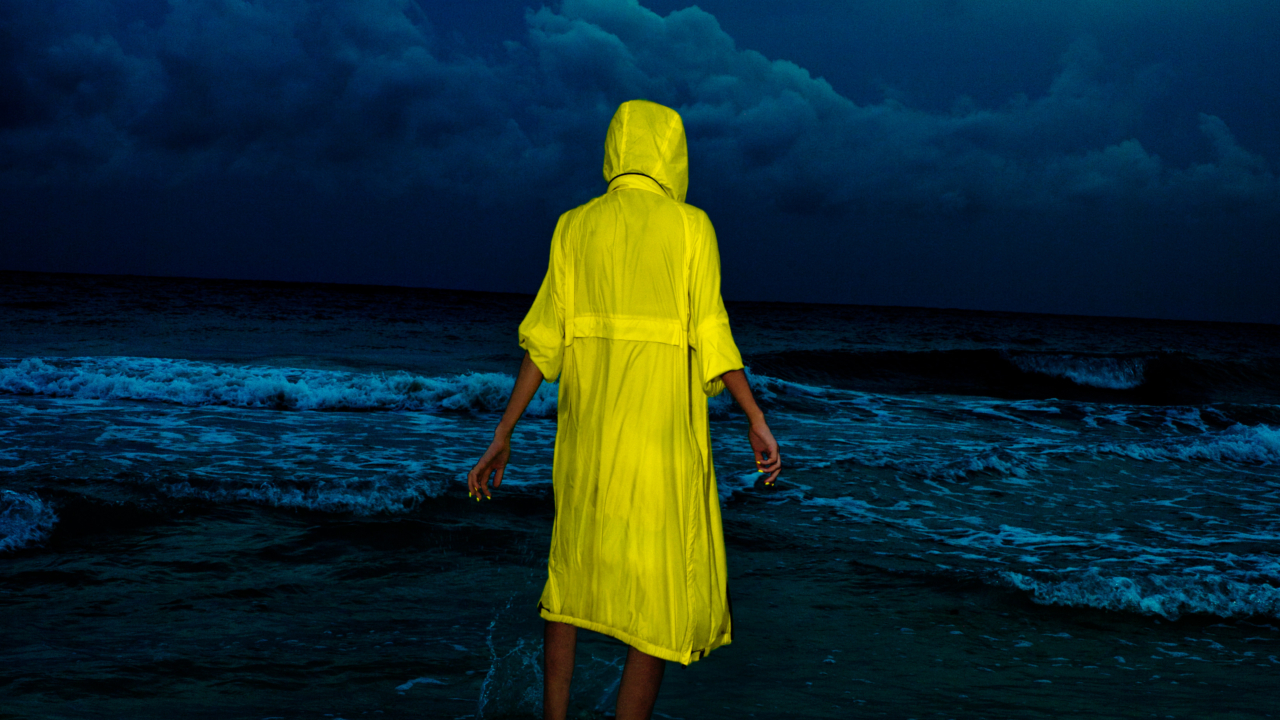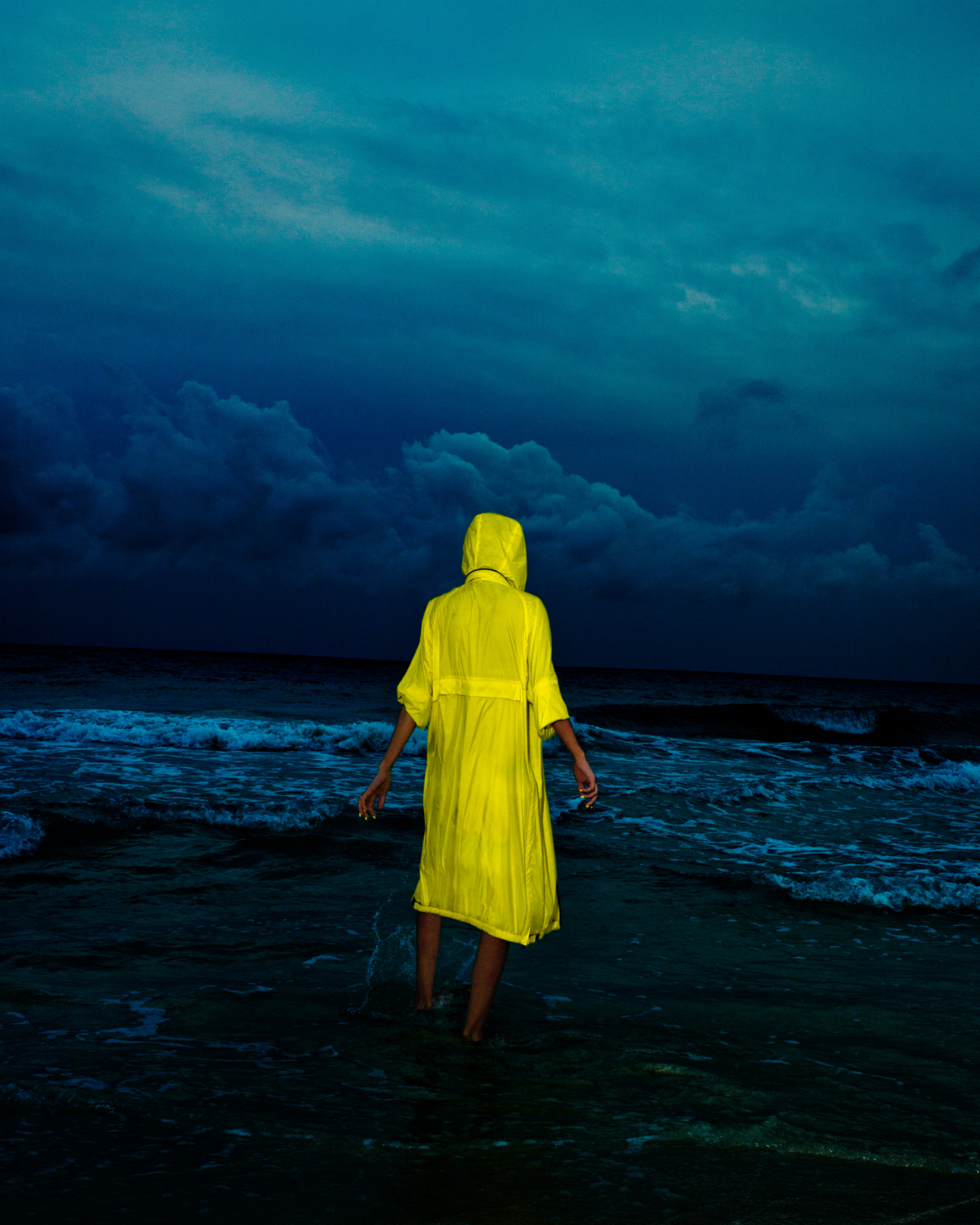

Photograph by Enrique Badulescu / Trunk Archive
Words by Zoe Suen
At first glance, Nike’s new tech collection looks built for a world on the brink. The fleeces come with air ventilation panels that channel airflow for easier breathing and sweat-wicking layers that promise to keep the wearer dry through extremes of heat and cold. It’s gear made for endurance, resilience, and a fast-changing climate—factors that are reshaping the entire fashion system.
Swept up in an ever-quickening trend cycle, it now seems that everyone, from cheap high street brands to lionized luxury houses, has embraced the high-performance shell, the quick-drying layers, the rugged boot, and the utility vest. Even if our technical gear only takes us to the neighborhood coffee shop, we are all increasingly dressing for survival. Or, at the very least, the illusion that we could survive if the moment ever required it.
On the surface, that might seem like a sensible adaptation for turbulent times. But what if the blueprints for this modern climate uniform were drawn up in war and in the environmental damage it left behind?
That unsettling paradox sits at the heart of the modern wardrobe and forms the crux of Gear, the latest series within Avery Trufelman’s acclaimed podcast, Articles of Interest. Across seven episodes, and following two years of research, Trufelman traces how the United States military has shaped North American outdoor wear—and by extension much of global fashion—connecting the sweatshirts and sneakers that fill our closets to the laboratories of military research and development.
“I would wager that every single garment and accessory I have ever reported on has had some connection to war,” Trufelman says in the first episode, which premieres on October 22. But the irony is stark. The U.S. military is globally recognized as one of the largest institutional polluters, yet its designs have come to define what we wear to protect ourselves from the climate instability it helped create. As the second season of Gear reveals, militarism has become the invisible architecture of consumer culture, dictating both what we wear and how we imagine survival.
For years, Trufelman has studied American fashion with a simple premise: that the country’s enduring cultural legacy is most prominently written in its mass-produced clothes.
After unpacking the social factors driving the rise of preppy fashion in her previous series, American Ivy, Trufelman turned her attention to militaria. “It’s worth examining where these clothes come from because they represent really different things,” she told Atmos. “Preppy clothes are rooted in notions of class and institutional belonging. Whereas the military is into notions of: What is power? What is masculinity? What does it mean to be rugged? What does it mean to be self-sacrificing?”
The earliest forms of American outdoor wear, she notes, were built on colonial foundations and a manufactured masculine ideal. The settler’s buckskin uniform was adapted from designs made by Native American women. The U.S. Army’s blue uniforms were dyed with indigo grown on slave plantations. And the revival of militarism in the early 1900s—a reaction to the pacifist movements of the time as well as the rise of the educated, urban “new woman”—reasserted a vision of manhood defined by combat and hierarchy.
“I would wager that every single garment and accessory I have ever reported on has had some connection to war.”
But the most decisive turning point for military uniforms, and subsequently civilian fashion, was World War II. The American soldier was still largely clad in heavy wool overcoats, which became death traps in cold, wet climates on the eastern front of Europe. So, the Army Quartermaster Corps responded by recruiting experts in outdoor gear, including Eddie Bauer and L.L. Bean, as consultants tasked with developing lighter, weather-resistant uniforms and equipment for harsh environments; A move that effectively merged the nation’s outdoor industry with military R&D.
Such collaborations spawned a revolution in design, including the development of hallmarks like the field jacket—the template for virtually every civilian jacket that followed—and the now-standard layering system of base, mid, and shell thermal layers. These trends didn’t evolve gradually, over years, either. Designers moved directly from military contracts to commercial production, selling civilian versions through their own brands even as they continued to supply soldiers. Because U.S. military uniforms must be manufactured domestically for security reasons, it was easy for local factories to start producing outdoor gear for consumers en masse.
Today, “there’s hardly a reason [for] an American factory [to] make thread without the military,” Trufelman said.
Material innovations didn’t stop with the Second World War.
In the decades that followed, advances including lightweight nylon, synthetic insulation, and Gore-Tex refined the military’s design formula. Mid-century brands like The North Face and Patagonia built their fashion empires on those breakthroughs, selling function and rugged self-reliance to civilians. Even taglines such as “leave no trace” that were born on the battlefield were later adopted by campers and hikers.
To be sure, these innovations transformed outdoor life, making hiking, camping, and mountaineering more accessible than ever. Lightweight, waterproof gear allows people—including families and children—to stay outside longer, trek farther, and experience nature with unprecedented safety and comfort. But as technical innovation continued to spill beyond the trail and into everyday life, performance fabrics and pragmatic silhouettes became just as popular among designers in fashion capitals like Paris, London, Tokyo, and Milan.
So much so that the rich and powerful have now swapped bespoke tailoring for utility-driven wardrobes. At luxury boutiques, sales staff are trained to spot customers wearing Arc’teryx jackets and On Running sneakers. What began as functional design has quickly become a status symbol: The shell jacket, once built to protect soldiers from the elements, is today a marker of comfort and security that only some can afford.
The influence of military design now shows up most starkly in who these protective trends leave behind, including low-income communities, unhoused people, and those displaced by climate disasters. Tracing that inequity is central to Gear’s narrative, from the “golden age of military surplus” in the 1940s, when a good tent was within reach for most American families, to the present day.
Trufelman recalls the dissonance she witnessed when visiting the Functional Fabric Fair, an industry showcase for “climate-ready” textiles. Outside, under the show’s banner proclaiming life is best lived outdoors, unhoused veterans squatted in temporary shelters. “As much as I vehemently oppose the military-industrial complex and hate the institution of war, through this research I’ve met so many soldiers for the first time in my life,” she said. “They’re amazing people, and I do want them to be warm and protected and dry. I don’t think that is bad. I don’t think anti-war rhetoric is anti-soldier rhetoric, and it’s really hard to square that circle.”
It’s no coincidence that Articles of Interest arrives during President Donald Trump’s second term, as far-right politics and ideals of rugged individualism and “masculine energy” regain cultural traction. The second season of Gear shows how such values, embedded in design and consumer culture, have long deepened inequality. And that the greatest threat isn’t the weather, but the inequities that leave those with the least protection to shoulder the impact of crises decades in the making.
Why We’re All Dressing For The End of the World